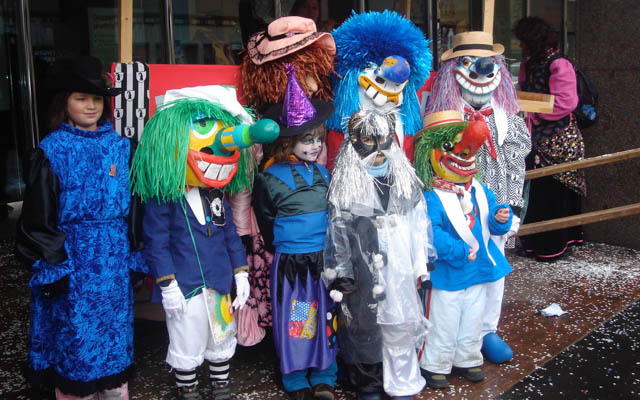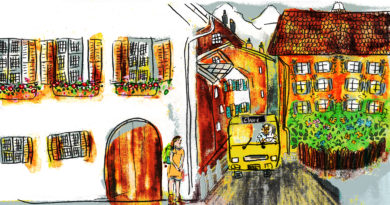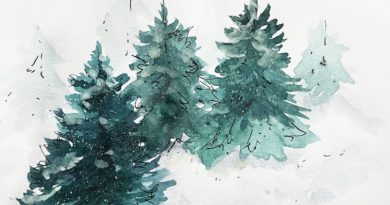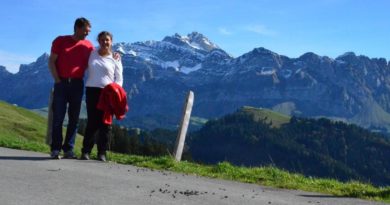Finding Your Fun at Basler Fasnacht
Before you and your kids set off for either a part or the full three days of Fasnacht (Carnival), it is important to know that Basler Fasnacht is all about having fun but it is, in good Swiss manner, regulated fun – there are a few rules and traditions that need to be followed in order to enjoy and understand the full scope of this wonderful, traditional city feast of feasts.
The first thing you need to know for the Basler Fasnacht is that there is a strict division between the Fasnachtler (active participants of Fasnacht) and the onlookers. As an onlooker you need to buy a badge, or Blaggedde/Plakette. They are easy to come by, because special vendors appear in the shopping streets and corners of the city as early as mid-January, shouting out “Blaggedde!” but you can also get them on the day you visit, even once Fasnacht has begun. Every visitor needs one of these badges, whether it is a nine-franc copper one or a 100-franc “Bijou” one, and it needs to be visible at all times. The proceeds go to the Fasnacht committee, which means that only if you wear one will you be safe from being stuffed with confetti by vicious-looking Fasnacht Waggis (the traditional costume wearers running around wearing huge masks and wooden clogs), who often drag offenders up to their wagons (not children – don’t worry!) and even give them a confetti bath! (This is the bath with the longest-term effect you will ever have, as the confetti bits appear months later, hidden in a scarf or dropping out of a sock.) But it is essential to remember that it is strictly forbidden for any visitor to throw confetti (or anything else) at any of the Fasnachtler. Ever. No exceptions. Just imagine wearing one of those masks with only two tiny nostrils to see through – confetti within that confined space would be quite scary!
This brings me to the next point. During Fasnacht it is also good to understand some terms: the amazing masks they wear are called Larve and are not to be compared to the German Fasching costumes. Furthermore, it is absolutely frowned upon when onlookers dress up in fancy dress costumes, that is, except for children. The second most important fun thing at Fasnacht is, of course, the colourful confetti that is blasted in huge rainbow clouds all over town. This is called Räppli, and again, even though it can be bought, never throw any at any of the official Fasnachtler. They can get quite angry under those masks. It is also the time of the year when everyone bonds, calls each other “du,” and any stop at a sausage stand or in one of the home-made café bars can end up in a fun-filled chat with a bench neighbour as you drink your hot chocolate or try the typical Fasnacht meal. This is, of course, white wine for the adults – all the active Fasnachtler wear a tin cup on a chain around their neck and each wagon has litres of white wine stacked away for their three-day trek – and to eat, Chääs Chueche (savoury cheese tart) or Ziibele Wääie (onion tart) and of course the delicious Mählsuppe (a thick broth made from flour) sprinkled with cheese. The best bit is that you can eat at any time all over town during all Fasnacht hours.
Now that you know a few expressions, what you will be eating, and how to behave as a spectator, lets have a look at the event itself. It starts on Monday morning at 4:00 sharp. This magical, thrilling moment is called Morgestraich. All of the crowds gather as of 2:00 – there are extra trains that get you into Basle SBB from anywhere in Switzerland, so please check the official SBB website. The excitement is contagious. But it does get very crowded, so make sure if you come with children to not go to places like Marktplatz, with confining walls behind you, but preferably up on the side streets. The effect is the same, because at 4:00 sharp all the lights are turned off and everyone waits – two, three, four – for all of the Cliques to start the march of the Morgestraich at the same time. The Drommle (drums) are joined by the piccolo and after one verse they all begin their first steps in unison. There is something very primal about the joint excitement and the march music that seems to bond people from all ages and backgrounds; you can’t help but smile!
My smile doesn’t wear off until the final day. After the Morgestraich, people trudge home to sleep, the confetti sweepers take over as the first business people wade their way to their offices across the empty streets, and everyone else prepares for the official parade that starts at 14:00. Here again, the onlookers start off at a set place, like one of the bridges or Marktplatz, and one after the other you can watch the creative wagons with their themes of the past year. The themes are usually local or international political satire, and the corresponding poems are handed out by the clique members on long strips of paper. Oranges and sweets and all sorts of interesting gifts are thrown out at the onlookers, along with showers of confetti and the yellow-flowered Mimösli. Remember that wherever you walk, the Fasnachtler have right of way; they can be quite determined if need be. The evening is a great time to stroll around through the old part of Basle, up by the university, where the smaller Cliques drum and play piccolo, enhancing the medieval character of the cobbled streets.
Tuesday afternoon is the official Kinderfasnacht parade. This is where the children onlookers are also encouraged to dress up. The wagons are full of excited kids who throw sweets at the onlookers and try to attract them to approach the wagon, where they are tricked into receiving a confetti shower. But again: remember never to let your child throw confetti at the kids in their wagons!
Tuesday evening is the brass band concert for those of you who like jolly and very loud music. This is held at the Marktplatz and also at the Barfüsserplatz. Again after the concert is a great time to march along behind bands and Cliques and to explore all the cellars that are only open to the public during these three days.
Wednesday afternoon is the final parade, where all the cliques wear costumes of Fasnachts past, and following this is everyone’s final chance to roam the streets until at 4:00 the next morning, the moment comes when people sadly bemoan how quickly these most important three days in Basle flew by.
In 2017, Basle Fasnacht takes place 6 – 8 March. You can find all information regarding Fasnacht, in English, on the official website.
Text and photos by Karin Mohler
Karin is a former expat, having settled down in her native Switzerland after a childhood abroad. She is challenged daily with balancing the peculiarities she picked up on her travels and integrating them into daily life in what is supposed to be her homeland. Her three children aged 15, 13 and 9 help her bridge the gap in understanding the culture she is now living in. Failing that, she gains insight and inspiration from the book: Third Culture Kids: Growing Up Among Worlds, by D. C. Pollock and R. v. Reken (2009).




